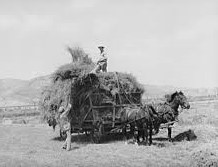MAKING HAY WHILE THE SUN SHINES
CATEGORY: LATE CHILDHOOD
PHOTO: 1) MAKING HAY WITH HORSES
2) HAY RAKE

The summer before my first year in high school was the last summer we spent In Grass Valley. It was the summer I helped My Uncle Wallace make hay. This may not have been before bailers were invented, but it surely was before such a thing was used on our ranch, or any place that I knew of in Sherman County.
The process of making hay was to plant the outside swath (a border about 12 to 15 feet wide) of a grain field with “hay seed” or the seed that would produce the best hay. If I remember correctly, on our ranch this was barley. This hay swath would be cut first, before the wheat was harvested, so that when the combine came into the field, with its great long cutter bar off to one side, the tractor and the combine would have a place to move without trampling any of the grain to be harvested. It was therefore called a “right of way.”
Uncle Wallace used horses to cut the hay with a sickle bar. It was left in the field until it was dry. We may have wished for rain at any other time, but never then. It was important for the hay to be dry; if it were not, it would catch fire by spontaneous combustion and probably burn the barn down. When the hay was ready Wallace would hitch the horses to the hay rake and rake it into windrows.
 The windrows were across the right of way every twenty or thirty feet. After that we would go into the field and pitch the windrows into shocks. Shocks were just little hay piles that were then easy to pick up with a pitch fork and pitch into the header bed: a wagon with one low side so the hay could be loaded more easily.
The windrows were across the right of way every twenty or thirty feet. After that we would go into the field and pitch the windrows into shocks. Shocks were just little hay piles that were then easy to pick up with a pitch fork and pitch into the header bed: a wagon with one low side so the hay could be loaded more easily.
After the hay was loaded, the horses pulled the wagon to the barns and the hay was pitched into the lofts. There were two barns that needed to be filled at that time: the cow barn and the horse barn. The horse barn was cut into the side of the hill on the other side of the valley, so it was easy to fill from the upper side. There was a large straw shed also cut into the hill farther up the valley, but it was filled after harvest with straw and chaff from the combine.
The cow barn was not cut into a hill, so filling it was more difficult. Many larger farms than ours had a more advanced loading system in which the ridge beam of the barn extended beyond one gable end supported by angle bracing–one brace on each side with their lower ends anchored lower down on the roof. These triangular sections were then roofed, making the barn look like it was ready to start flying, but only with one wing. The extension supported the outer end of a track which went all the way to the back of the mow under the barn ridge. The track held rolling clamps that in turn held a cable. At the outer end, the cable hung down from a pulley and ended with big grabber teeth. These teeth could be lowered and opened to sink their fangs into a huge mouthful of hay, lift it and transport it clear to the back of the hay loft along the track.
Not having such modern miracles, Uncle Wallace had to pitch the hay out of the wagon into the hay loft by hand. He would open the big barn doors into the center part of the barn, drive the horses into the barn so the front of the wagon was even with the doors, and pitch the hay up through the hay door into the mow. From there it was pitched further back: that summer by me. When the front of the wagon was empty, he would move the horses further into the barn and pitch up the rest of the load.
It was a labor-intensive process. I am amazed that Wallace could survive doing it year after year. He was amazed that I could survive it for just one season, and so was I. I hated the dust and the itching particles that got into my clothes, but I found that I enjoyed the physical exertion. I became proud of how much hay I could lift in one forkful. I liked to surprise my uncle by lifting as big, or almost as big, a forkful as he could. My reward was that I could take a bath in the long bathub at the ranch at the end of each day. What luxury! I would put my whole head under water and blow bubbles.
They must have been the bubbles of my dreams for the future, since I knew that at summer’s end we would be moving to Moro, ten miles away, and I would be going to high school. I thought that once I was in high school I would never be a child again. Little did I know that I would spend the rest of my life growing up.
